(WGN) — The Illinois Department of Corrections doesn’t know how many recently released prisoners have gone on to commit new crimes, WGN Investigates has learned.
Tracking recidivism rates are a key metric to determine whether the state is effectively rehabilitating convicted criminals or merely warehousing them. In fact, reducing recidivism is mentioned two dozen times in IDOC’s most recent annual report. However, IDOC officials acknowledge they have not been able to calculate the recidivism rate since 2022 due to what they describe as a computer “programming issue.”
In 2022, the last time the number was updated, IDOC reported just under 37-percent of inmates re-offended within three years of their release.
The blind spot is happening at the same time IDOC has refused an offer of help – outlined in state law – from a suburban sheriff who says he can be more effective at making sure fewer convicts re-offend when they’re released.
“Your public safety in every county across the entire state and country starts right here in the jail,” said Kane County Sheriff Ron Hain. “What we do or don’t do to improve people’s lives will directly result in whether they recidivize, create more crime and come back in.”
Sheriff Hain partnered with State Rep. Matt Hanson (D-83rd district, Batavia) to pass a law they hoped would better prepare inmates for life beyond prison walls. The law passed the Illinois General Assembly unanimously. It said, if the local sheriff was willing, state prisoners could be transferred back to county jail for the final few months of their sentence to receive localized and specialized re-entry services, everything from substance abuse to job training and housing help.
“Not a single person has been able to take advantage of this law,” State Rep. Hanson said while acknowledging the text of his bill said IDOC “may” instead of “shall” do so. “They might be afraid the success that Kane County would have would illustrate they need to have a [better] re-entry program themselves.”
Lighthouse Recovery has partnered with the Kane County Jail for years to offer services for jail inmates, most of whom are awaiting trial or being held for shorter sentences. “What we provide here is therapy, opportunity and then when they go to IDOC, sometimes that gets unraveled. What we’d like is for them to come back here so we can set them up again,” said Lighthouse Recovery’s Nathan Lanthrum.
“People are worried about violent criminal offenders, people with drug charges, people with backgrounds coming back to their community,” Lanthrum said. “The point is: They are coming back to the community. What can we do to help them?” Lanthrum said.
Sheriff Hain said his offer to feed, house and provide re-entry services to state prisoners from Kane County before their release has gone unanswered. “We’re not charging IDOC to do this,” Hain said. ” We are taking on that investment in the person. They’re actually going to save money. They’re actually going to keep people from recidivizing. It’s just a smart investment across the board.”
An Illinois Department of Corrections spokesperson said her agency provides a host of education, job, health and other programs to prepare inmates to return to society. IDOC also helps eligible inmates enroll in food benefit programs and Medicaid prior to release. IDOC spokesperson Naomi Puzzello would not address why her agency has been unwilling to take Kane County up on its offer.
As for IDOC’s inability to calculate the current recidivism rate since 2022, there’s no word when it might be restored. “There’s a programming issue with the file that generates those calculations and report… IT is working on the issue,” IDOC’s Puzzello wrote in an email.
Copyright 2025 Nexstar Media, Inc. All rights reserved. This material may not be published, broadcast, rewritten, or redistributed.
For the latest news, weather, sports, and streaming video, head to WGN-TV.









